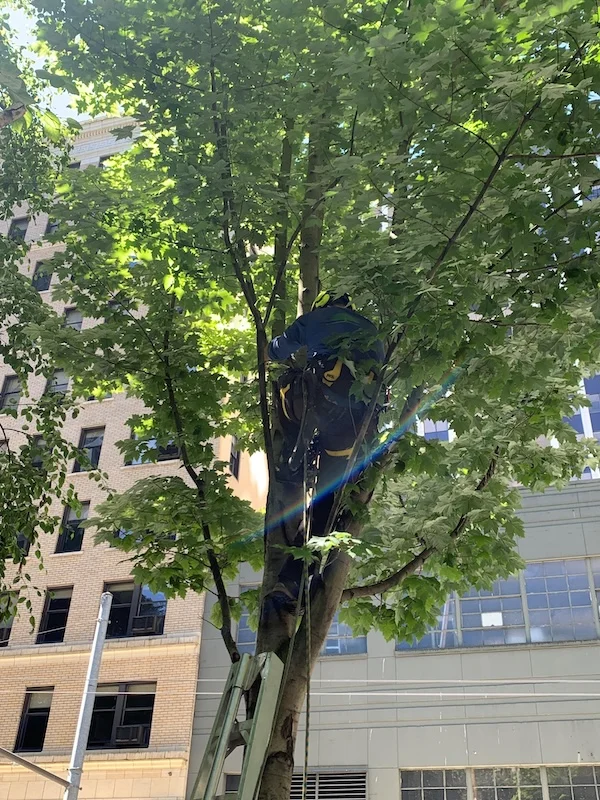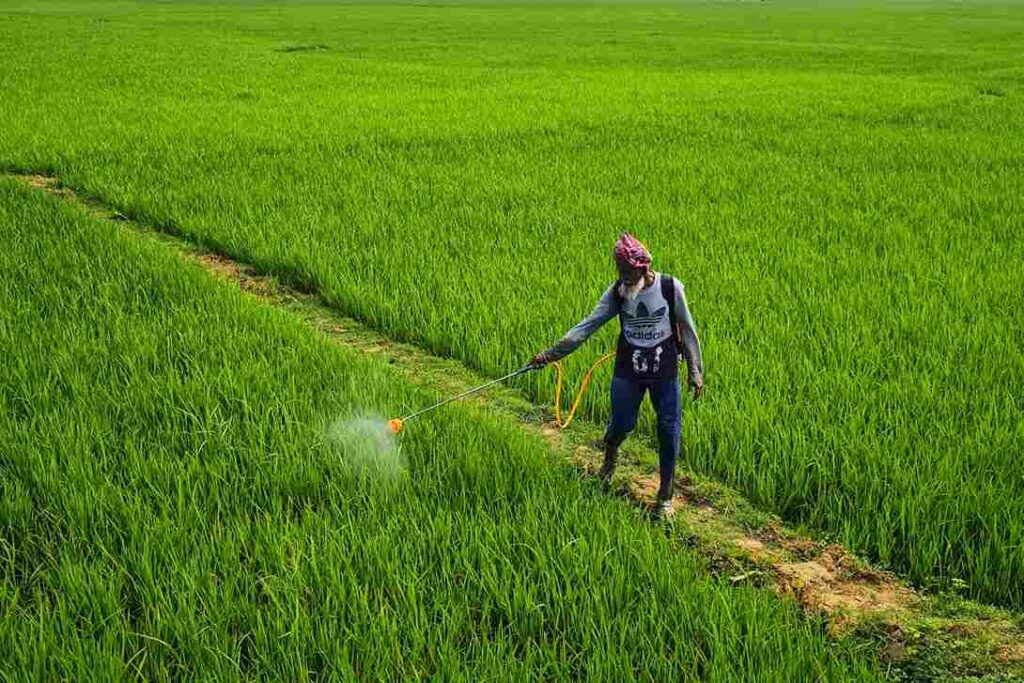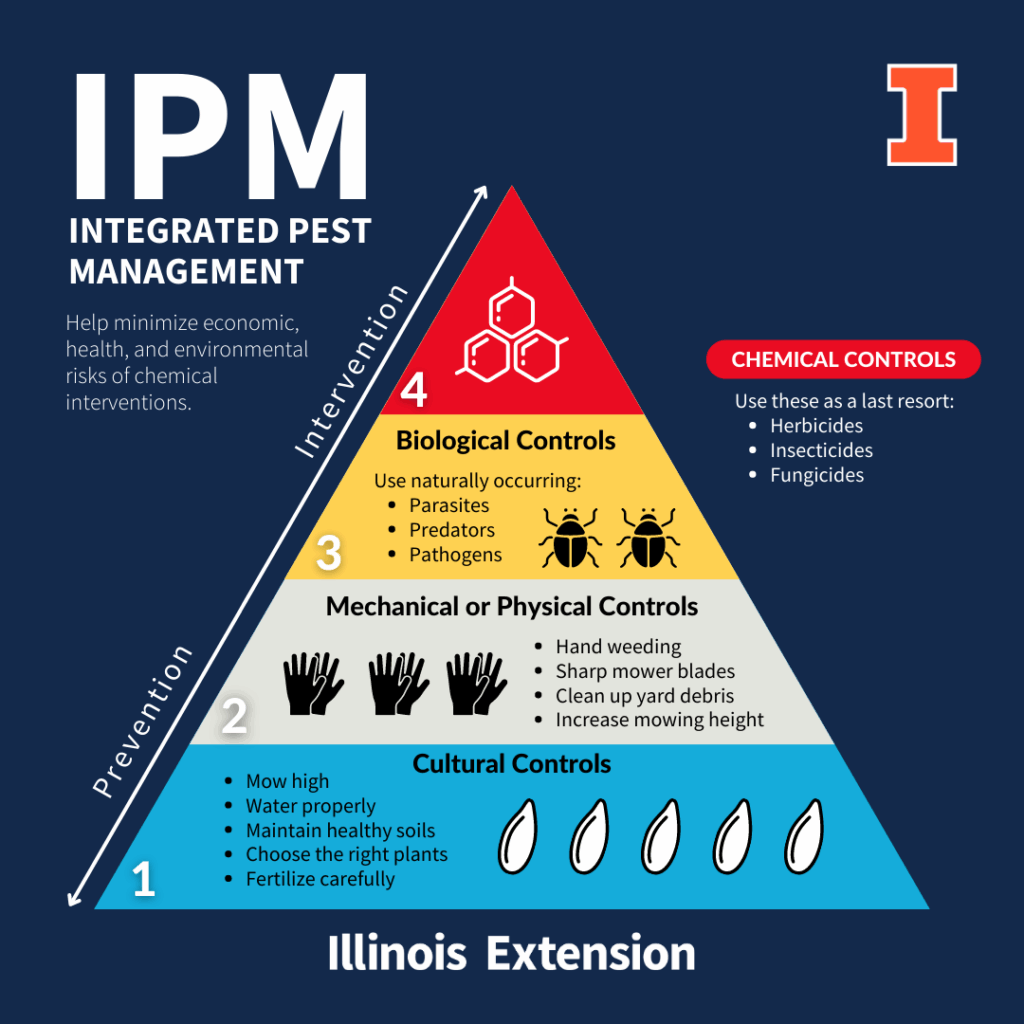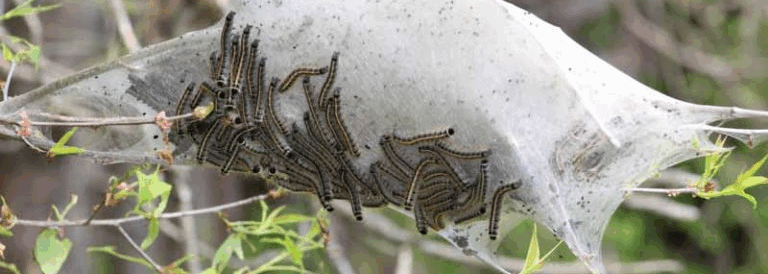Tent caterpillars may promptly transform a flourishing tree into a weakened, decaying mess. Their webs dangle from branches, and their ravenous larvae devour foliage at a staggering speed.
The bright side is that there are effective measures to deal with them. This in-depth guide by our professional tree care manager Allen Tate will take you through seven tried-and-tested approaches with over 90% success rates.
There are remedies for preventative and existing infestations, including manual removal, winter egg scraping, organic sprays, and integrated management procedures. Using these approaches, you can preserve your landscape while keeping your trees flourishing.

Annual life cycle of tent caterpillars showing egg, larva, pupa, and moth stages with seasonal timing.
When to Take Action Against Tent Caterpillars (Timing – Critical for Success)
When it comes to tent caterpillar control, time is critical. All strategies work best in the first two weeks of larval activity, when the caterpillars are less than an inch long. Acting early in the season can result in up to 95% success, whereas waiting until larvae are completely matured limits efficacy to about 40%.
Spring is the ideal time to suspend tent construction and feeding. Winter egg removal is the most effective protection, although late-season treatments may lessen damage but seldom eliminate it entirely.
When a tree undergoes substantial leaf fall by the middle of summer or afterwards, no further sprouting will occur until the next year. At this point, concentration should be on improving the tree’s vital functions for the following year’s development phase. This includes maintaining irrigation, reducing stressors, and ensuring soil conditions promote recovery and resilience.
Method #1: Manual Tent Removal (Immediate, Chemical-Free Solution)
Caterpillars gather in their silk nests during sunrise and evening, so striking them at that time is the perfect move.
- This strategy has a 90–95% success rate, which is rather impressive, particularly since it doesn’t include chemical assistance. A great deal of non-chemical solutions fall well short of those numbers. From a technical standpoint, that is immensely impressive.

Figure 1. Silken tent nestled in the crotch of tree branches, easy to remove manually at dawn or dusk. (Image Credits: gardenerspath.com)
Use a sturdy tool or put on long-lasting protective gloves when removing nests from trees. Strict avoidance is recommended since caterpillar hairs might cause serious dermatological problems.
Following removal, the nest needs to be tightly packed in a plastic bag and frozen, or else immersed in soapy water to guarantee that any eggs or larvae are removed. This effectively halts any potential spread.
- Manual removal is basically the go-to, non-chemical option when you’re dealing with tent caterpillars on young trees, ornamentals, or limited infestations. You’re not going to clear out a massive swarm on a huge, mature tree this way, but for smaller jobs? Works like a charm.
Physically removing conspicuous nests and doing routine tree inspections are usually efficient ways to control pest populations. This manual method minimizes disruption to local ecosystems and is quite affordable. For individuals interested in integrated pest management, this offers an effective substitute to extensive chemical-based treatments.
Method #2: Winter Egg Mass Removal (100% Prevention Strategy)
Winter egg-mass removal is the most effective strategy for preventing infestations prior to they develop.
- An egg mass ordinarily holds 150-350 caterpillars. Physically getting rid of those egg masses can halt the pest’s lifespan ahead of the larvae show up in spring, radically reducing population growth.

Figure 2. Shiny, dark brown tent caterpillar egg mass encircling a twig, a prime target for winter scraping. (Image Credits: uaex.uada.edu)
The shiny, dark brown egg clusters you see on branches are an immediate indication of tent caterpillar activity. The most productive time for eliminating these clusters takes place between November and March, when the trees are defoliated and egg masses are effortlessly visible.
Taking down and discarding these clusters preceding spring is an attainable and cost-effective way to safeguard against tent caterpillar infestations, avoiding the need for chemical interventions.
For sustained control, it is advisable to regularly inspect host trees during the colder months, and eliminate any egg masses encountered. Addressing the issue at this early stage greatly decreases the likelihood of significant outbreaks in the subsequent growing season.
Method #3: Bacillus Thuringiensis (Bt) Application (Organic Biological Control)
The bacterium Bacillus thuringiensis (Bt) is acknowledged in organic pest management, due to its concentrated mode of attack. It is designed to constrain caterpillar larvae while leaving non-target creatures.
If environmental impact is a concern, BT pretty much takes the lead in sustainable pest management. Its targeted action really appeals to those looking for solutions that don’t wreck the environment. Upon ingestion of Bt-treated foliage, caterpillars experience a rapid termination of feeding, typically resulting in death within several days.

Figure 3. Applying Bt spray to affected foliage while caterpillars are still small, an organic and OMRI-approved method.
- Timing is essential for Bt. When administered to caterpillars under an inch long, success rates surpass 90%. Sprays against larger larvae, however, lose effectiveness below 60%. Results are improved with consistent foliage coverage and reapplication following heavy rain.
For operations which must adhere to ethical standards, Bt is an ideal choice because it has been formally certified for application by the Organic Materials Review Institute (OMRI).
Method #4: Spinosad and Other Biological Insecticides
Spinosad, a naturally produced insecticide, provides effective control of slightly larger caterpillars. It acts by interrupting the neurological system, causing the insects to cease feeding and eventually die. When used correctly, spinosad can reach 80 to 90 percent efficacy.

Figure 4. Spinosad-based biological insecticide effective against caterpillars and safe for targeted use.
Spinosad stands out as an worthwhile alternative, or even as an accessory to Bt for individuals hoping to steer clear of synthetic chemicals while still achieving strong pest control.
Spinosad’s wide applicability is effective across both ornamental and food crops which makes it a valuable resource for cultivators. When used in conjunction with Bt, it hinders the pest population from building resistance.
This is an important aspect of integrated pest management structures. This strategy effectively extends the success rate of both treatments while also supporting in keeping track of our pest control objective.
Method #5: Dormant and Horticultural Oils
Dormant oils are a great protective step in late winter. Spraying these oils coats trees and kills overwintering eggs, preventing them from hatching. Dormant oils, when combined with egg mass scraping and trimming, provide an additional layer of defense against breakouts. They are fairly affordable, widely available, and safe to use before bud break.

Figure 5. Blooma Crew Head (Steven Zipfel) Applying dormant oil spray during winter to prevent egg hatch in spring.
Merging oil treatments with consistent physical upkeep, like cutting down dead or infested parts of the tree, and directly removing pests offers a more robust strategy than using one solitary tactic.
Blending chemical and manual control methods delivers a more resilient shrinkage of pest populations gradually, which correlates with increased tree health and productivity.
Method #6: Chemical Insecticides (as a final measure)
Severe infestations of pest populations will justify the application of chemical pesticides, and only then. Use of certain products containing pyrethroid and carbaryl may be effective, though they do damage to the pollinators and other beneficial species. Safety equipment and the total abstinence of application of spray devices each spring are two vital self-protective measures.

Figure 6. Farmer in protective gear applying pesticide spray in a green field, an example of chemical insecticide use as last resort.
Chemical procedures continue to have a major role in extreme infestations, nevertheless they should only be used as an emergency measure as opposed to the routine protocol.
In conditions where trees have historical or environmental relevance, more extreme chemical treatments may be required to prevent permanent loss. However, considering the adverse environmental impacts, these kinds of procedures should be exercised solely in serious circumstances and avoided during standard operations.
Method #7: Integrated Pest Management (IPM) for tent caterpillars

Figure 7. Integrated Pest Management (IPM) pyramid showing cultural, mechanical, biological, and chemical controls for tent caterpillars.
Ultimately, Integrated Pest Management (IPM) serves as the most successful and environmentally conscious method for controlling tent caterpillar invasions. It combines preventive monitoring and treatment methods.
Spraying Bt early in the season, occasional manual removals, and fostering predatory creatures like birds and wasps are all part of a robust IPM strategy. IPM is flexible enough to adapt to property size and tree type. The emphasis remains on stabilizing effective management with environmental responsibility.
Control Method Comparison and Decision Guide
Controlling tent caterpillars isn’t a universally applicable operation, it’s fairly contextual. The period of year, tree species concerned, and the seriousness of the infestation all contribute to figuring out which technique will be most effective. Effective control demands ongoing observation, timely interventions, and the execution of precautionary measures.

Figure 8. Cluster of tent caterpillars gathered inside their silk web on a tree trunk.
Small Infestations (1-10 tents)
Physically removing nests can keep damage in check if the problem is on the small side. Manual removal works efficiently, taking less than 3 hours, and ranging between $0-30 based on what products you use.
Scraping off egg masses is a solid move for long-term prevention, basically eliminating 90-95% of next year’s outbreak before it starts.
Moderate Infestations (10-20 tents)
For a biological approach, Bacillus thuringiensis (Bt) is highly specific and safe, and it hits caterpillars hard, jumping from 85% to 90% effectiveness during seasonal change, leaving your beneficial insects alone.
Spinosad and dormant oils are additional tools, expanding your arsenal, ranging between $50-150, and time investment of 3-6 hours. All the while without resorting to harsher chemical insecticides, (which really should be your last resort for major infestations).
Severe Infestations (20+ tents)
Bringing all the above mentioned methods together in an Integrated Pest Management (IPM) plan, budgeted at $200-500, can seriously boost tree survival rates. Allowing professional handling and proper implementation of the designated plan typically ensures 95+% effectiveness.
What NOT to Do When Removing Tent Caterpillars (Critical mistakes to avoid)
- Burning tent caterpillars? Any expert botanist, or gardener will disagree. Directing flames to tree bark does far more than simply kill pests, it also risks harming the cambium, subjecting the tree to diseases and disfigurement, and not to ignore the evident fire threat. It’s fundamentally not an acceptable management strategy.
- Wide-spectrum insecticides? You may be able to regulate the caterpillars briefly, but you are also likely eradicating beneficial insects such as pollinators and predators. Secondary pest outbreaks are also a potential risk once natural adversaries are gone.
- Young caterpillars are simpler to control. Once they mature, control becomes more difficult, and tree stress increases. Finally, resist excessive pruning, gentle, selective pruning is allowed.
Monitoring Treatment Success (Measuring Effectiveness and Planning Follow-Up)
Should you still see any caterpillars within a week of removal, strike them again, or modify tactics. Do not slack off, inspect tents, and hunt for recent nests.

Figure 9. Close-up of Eastern tent caterpillars (left) and their silk web colony on a tree branch (right). (Image Credit: Photo: David Paulson & southcarolinapublicradio.org)
Within a few days, you’ll see lesser caterpillars as well as vacant tents. The emergence of fresh foliage signals that your tree is healing, and that you’re on the right course.
Compile observations on what you tried and what worked. If you have had enough of struggling with it, call the professionals.
Preventing Future Tent Caterpillar Problems (Long-Term Management Strategy)
Stay on top of tent caterpillars, never automatically react when you see webs. Routine control cuts down infestations from 80-90%, so maintain your trees on a standard annual plan.
- Fall: Tidy up fallen leaves and debris around trees to reduce pest habitat.
- Winter: Trim branches and neutralize tent caterpillar egg masses through scraping or dormant oil applications.
- Spring: Observe tree buds for early signs of caterpillar emergence and tent formation.
- Summer: Maintain proper tree hydration through watering and apply mulch to retain soil moisture.
Key Point: Healthy trees are substantially less vulnerable to tent caterpillar damage and recover more quickly from infestations.
Fostering birds like robins, cuckoos and blackbirds, and beneficial bugs like parasitic wasps helps diminish caterpillar numbers; do not employ strong insecticides to protect them.
Examine your trees weekly in the springtime for initial indicators. With climate change disrupting pest cycles, keeping adaptable is necessary. A seasonal tree care calendar will help you adopt a more consistent practice.
Frequently Asked Questions (FAQs)
What pesticide kills tent caterpillars?
The Bacillus thuringiensis (Bt) is the most effective organic pesticide against young caterpillars, with almost 90 percent success. In bigger caterpillars, spinosad has a wider range of control and is 80-85% active. Only in extreme outbreaks, pyrethroid-based insecticides (bifenthrin or permethrin) are applied, but only as the final option because of the harm they do to pollinators and beneficial insects.
What damage do tent caterpillars do?
Tent caterpillars strip trees leading to extreme defoliation. Although trees can tolerate one outbreak and be healthy, repeated attacks undermine trees, lessen flowering and fruiting, and predispose trees to secondary attacks by pests and diseases.
How long do tent caterpillars stay around?
The spring lasts 6-8 weeks during which tent caterpillars are active. Eggs are hatched in early spring, the larvae are very active in May and June, and the insects are reduced to a pupa in midsummer. The feeding damage and the ugly silk tents are usually contained within this narrow window.
Who eats tent caterpillars?
Birds like robins, blackbirds, orioles and cuckoos are also considered natural predators, as well as useful insects like predatory beetles and parasitic wasps. Promotion of such natural enemies is a key element in long-term tent caterpillar control.







